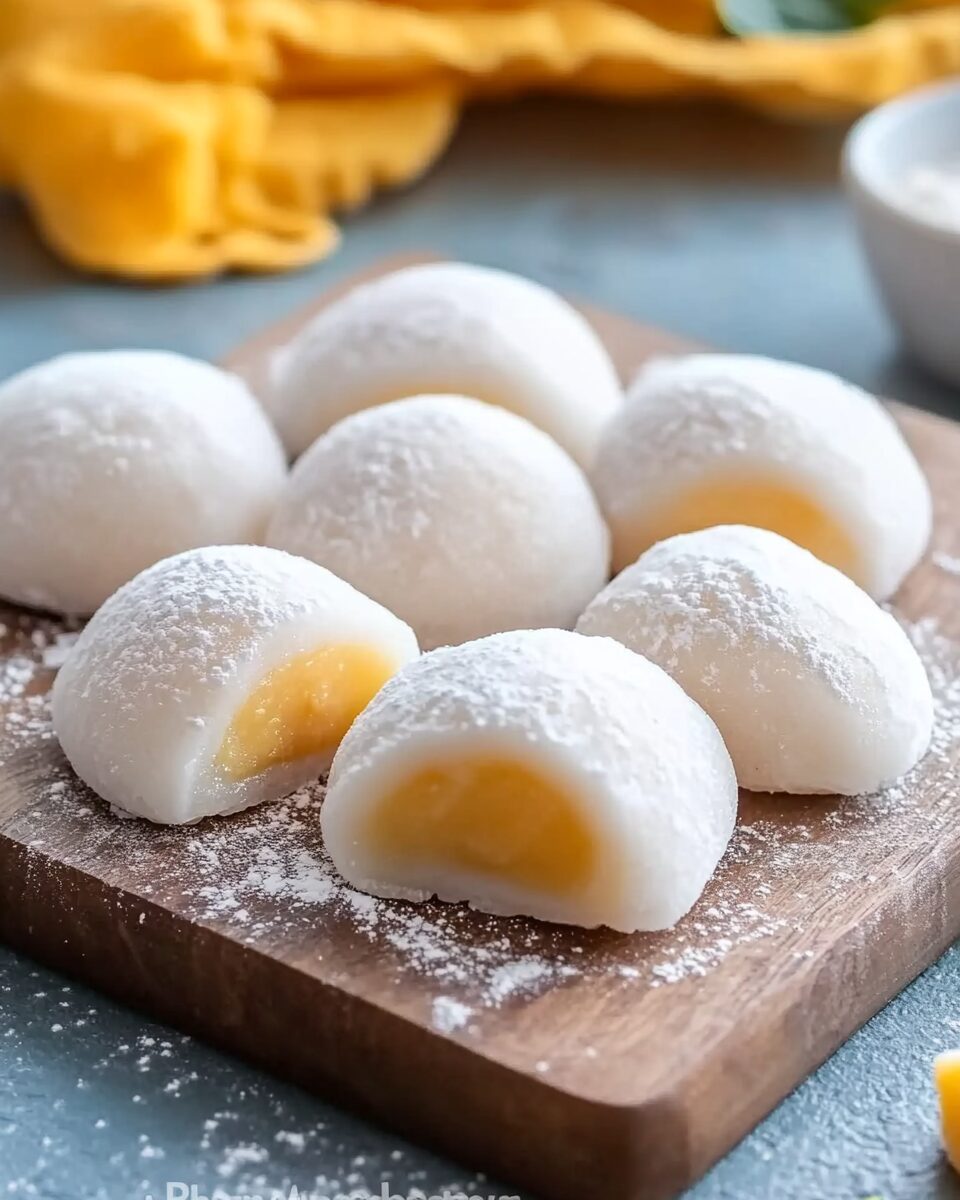Mango Mochi is a delightful Japanese-inspired dessert that combines the chewy texture of mochi with the tropical sweetness of mango. This gluten-free and dairy-free treat is perfect for those seeking a light yet satisfying dessert. With its vibrant flavor and soft, chewy exterior, Mango Mochi is sure to be a hit at any gathering or as a personal indulgence.
Full Recipe:
Ingredients
- 100 grams (3.53 ounces) glutinous rice flour (mochiko flour, sweet rice flour)
- 180 ml water
- 50 grams (1.76 ounces) white sugar
- Pinch of salt
- 130 grams (4.59 ounces) mango jam
- Corn starch, for dusting the work surface
Directions
- In a medium microwave-safe bowl, combine the glutinous rice flour, water, sugar, and salt. Stir until the mixture is smooth and free of lumps.
- Place the bowl on a plate and cover it with a microwave-safe lid. Microwave the mixture for about 1 minute and 30 seconds to 2 minutes (based on an 850-watt microwave) until it begins to form a paste.
- Carefully remove the bowl from the microwave and stir the mixture. Be cautious, as it will be hot and steamy.
- Return the bowl to the microwave and heat for an additional 15–30 seconds. Remove and stir once more. Allow the dough to cool until it can be comfortably handled.
- Lightly dust your workspace with corn starch to prevent sticking.
- Flatten the cooled mochi dough into a rectangle approximately 0.5 mm (0.02 inches) thick.
- Using a 6 cm (2.4 inch) cookie cutter, cut the dough into circles. Gather any leftover dough, reshape it into a rectangle, and repeat the cutting process until all dough is used.
- Place ½ to 1 teaspoon of mango jam in the center of each circle. Fold the sides into the middle and pinch to seal, forming a ball.
- Lightly coat each mochi ball with corn starch to prevent sticking. Place seam side down and serve.
Nutritional Facts
Per serving (1 mochi):
- Calories: 66 kcal
- Carbohydrates: 16g
- Protein: 1g
- Fat: 0g
- Sodium: 14mg
- Potassium: 7mg
- Sugar: 8g
The Origin of Mochi
Mochi has been a part of Japanese culture for centuries. Traditionally, it is made by steaming glutinous rice and then pounding it until it forms a sticky, smooth dough. The dough is then shaped into small balls or disks. Mochi has a long history in Japan and has been associated with various cultural and religious practices. It’s often consumed during New Year’s celebrations, symbolizing good luck and longevity.
The origins of mango, however, can be traced back to South Asia, where it is considered the “king of fruits.” Mangoes have spread across the globe, and they are now widely cultivated in tropical regions worldwide. The fusion of mango with mochi in Mango Mochi represents a cultural exchange, combining the best of Japanese and tropical flavors to create a truly exceptional treat.
The Allure of Mango Mochi
Mango Mochi is a dessert that captivates the senses. The chewy exterior contrasts beautifully with the sweet, fruity filling, creating an experience that’s both texturally satisfying and flavorful. The mango flavor is fresh, slightly tangy, and rich, which balances the mild taste of the glutinous rice dough. This balance makes Mango Mochi a refreshing treat, especially during warmer months or as an accompaniment to tea.
One of the standout features of Mango Mochi is its gluten-free nature. Made from glutinous rice flour, it’s suitable for individuals who avoid gluten in their diet due to allergies or dietary preferences. In addition, Mango Mochi can be adapted to meet dairy-free and vegan requirements, making it a versatile dessert option that can be enjoyed by many.
Mango Mochi as a Healthier Dessert Option
Mango Mochi offers a healthier alternative to traditional Western desserts, which are often loaded with refined sugars and heavy fats. While it still contains sugar, the amount is typically less than in many cakes or pastries. Additionally, mangoes are a rich source of vitamins A and C, which are essential for skin health, immune function, and overall well-being. They also provide dietary fiber, helping to support digestion. The glutinous rice flour used in the dough is naturally gluten-free, making it a safe dessert choice for people with gluten sensitivities or celiac disease.
Despite being a sweet treat, Mango Mochi doesn’t carry the same heavy caloric load as many desserts. When consumed in moderation, it can fit into a balanced diet without derailing health goals. However, it is important to note that like any dessert, it should be enjoyed in moderation. Mango Mochi provides a moderate source of carbohydrates and sugars, and while it may not be as calorie-dense as cakes or cookies, it is still a sugary indulgence.
The Cultural Appeal of Mango Mochi
Mango Mochi brings together elements from both Japanese and tropical cuisines, which contributes to its unique appeal. Mochi itself is a food with deep cultural roots in Japan, and it is often seen during major celebrations, particularly during New Year’s festivities. The addition of mango introduces a new layer of cultural fusion, and it’s an excellent example of how culinary traditions can blend to create something entirely new.
In addition to its rich cultural background, Mango Mochi is a food that celebrates simplicity. The ingredients needed to create this dessert are minimal and straightforward. Yet, when combined in the right proportions and prepared with care, the result is a dessert that is elegant in its flavor and texture. The simplicity of Mango Mochi means that it can be enjoyed by anyone, regardless of their cooking experience.
Making Mango Mochi: A Fun, Interactive Process
Making Mango Mochi is a relatively simple process, though it does require some patience. The most important part of the process is preparing the mochi dough, which is made by cooking glutinous rice flour with water until it forms a sticky paste. The key is to ensure that the dough has the perfect consistency—neither too thick nor too runny. Once the dough has cooled, it is shaped into small discs, which are then filled with mango jam or fresh mango puree. The filled discs are carefully sealed, creating little pockets of sweetness that are soft on the outside and deliciously fruity on the inside.
Mango Mochi is not just a treat for the taste buds but also a fun and engaging cooking project. It’s a great recipe for families to prepare together, allowing kids to help with the shaping and sealing process. Because the dough is soft and pliable, it’s easy to handle, making it accessible even for beginners. Additionally, Mango Mochi can be customized in terms of flavor and filling. If you prefer a tangier version, you can use mango puree with a little lime zest. Alternatively, you could experiment with other tropical fruits, such as coconut or passion fruit, to create your own unique variations.
Mango Mochi in Modern Cuisine
In recent years, Mango Mochi has gained popularity outside of Japan, especially in Western countries. The dessert has become a trendy item in Asian fusion restaurants, where chefs experiment with different flavors and fillings. Its rising popularity can also be attributed to the growing interest in Asian-inspired desserts, as well as the increasing demand for gluten-free and dairy-free options.
Mango Mochi is often served in small, bite-sized pieces, making it an ideal choice for party platters or dessert buffets. It pairs wonderfully with a wide range of beverages, from traditional green tea to more modern offerings like fruit-infused iced teas or even sparkling wines. Its versatility also makes it an attractive option for those hosting dinner parties, as it adds a touch of elegance without requiring much effort in preparation.
Conclusion: Why You Should Try Mango Mochi
Mango Mochi is more than just a dessert—it’s an experience. The chewy, soft dough pairs beautifully with the sweet, tropical flavor of mango, creating a treat that is both delicious and satisfying. Whether you’re making it for yourself, your family, or guests, Mango Mochi is a dessert that will undoubtedly impress.






